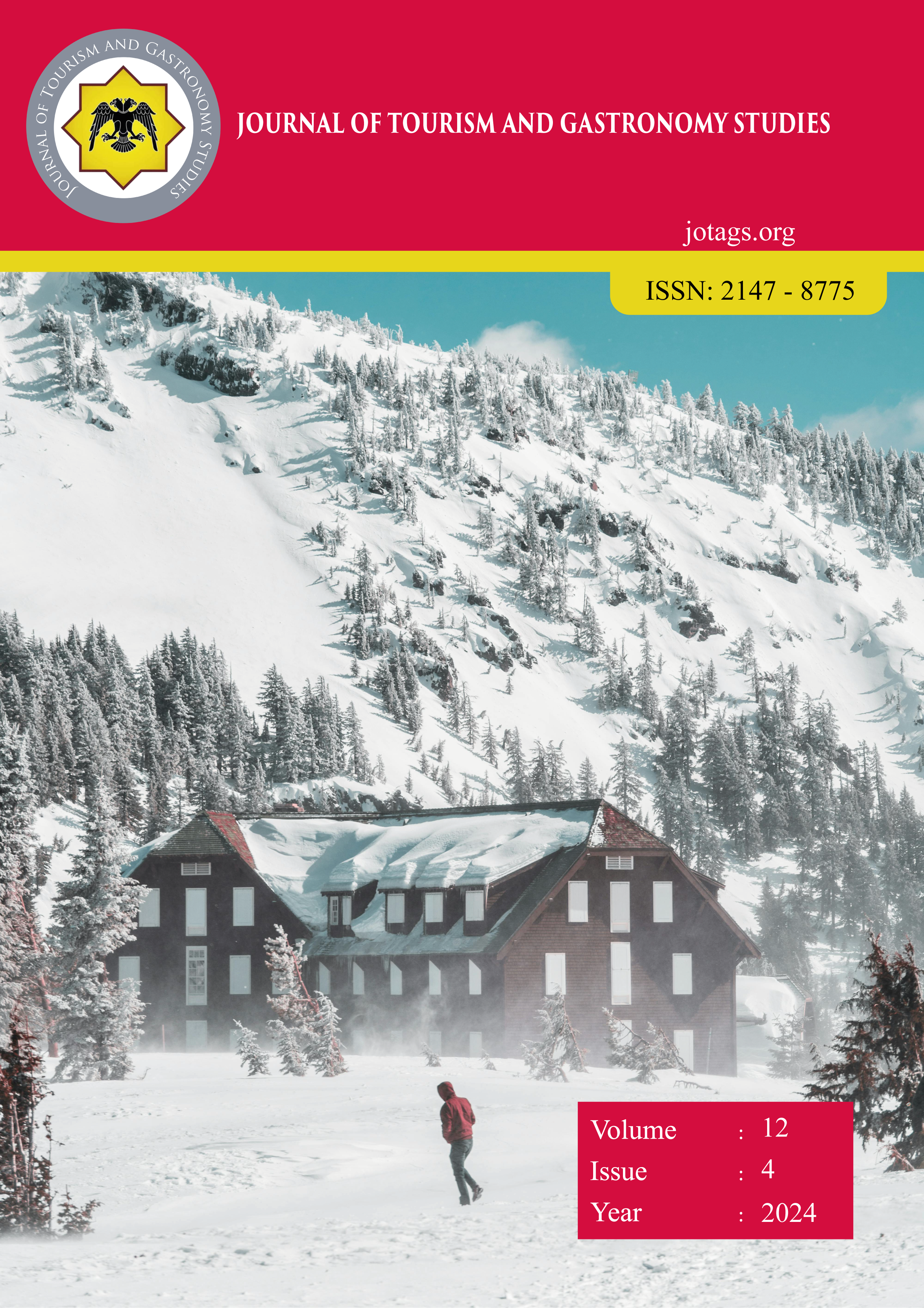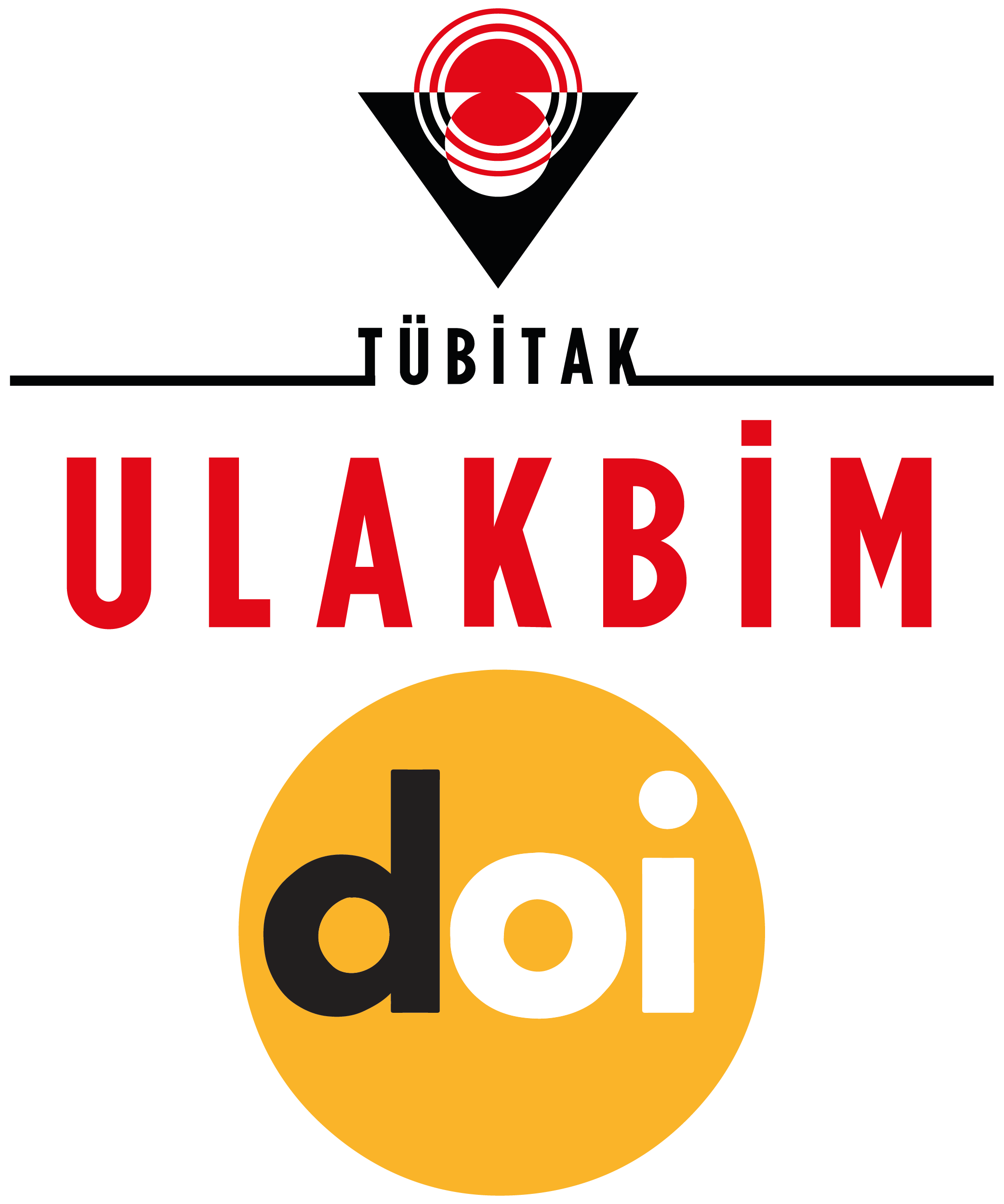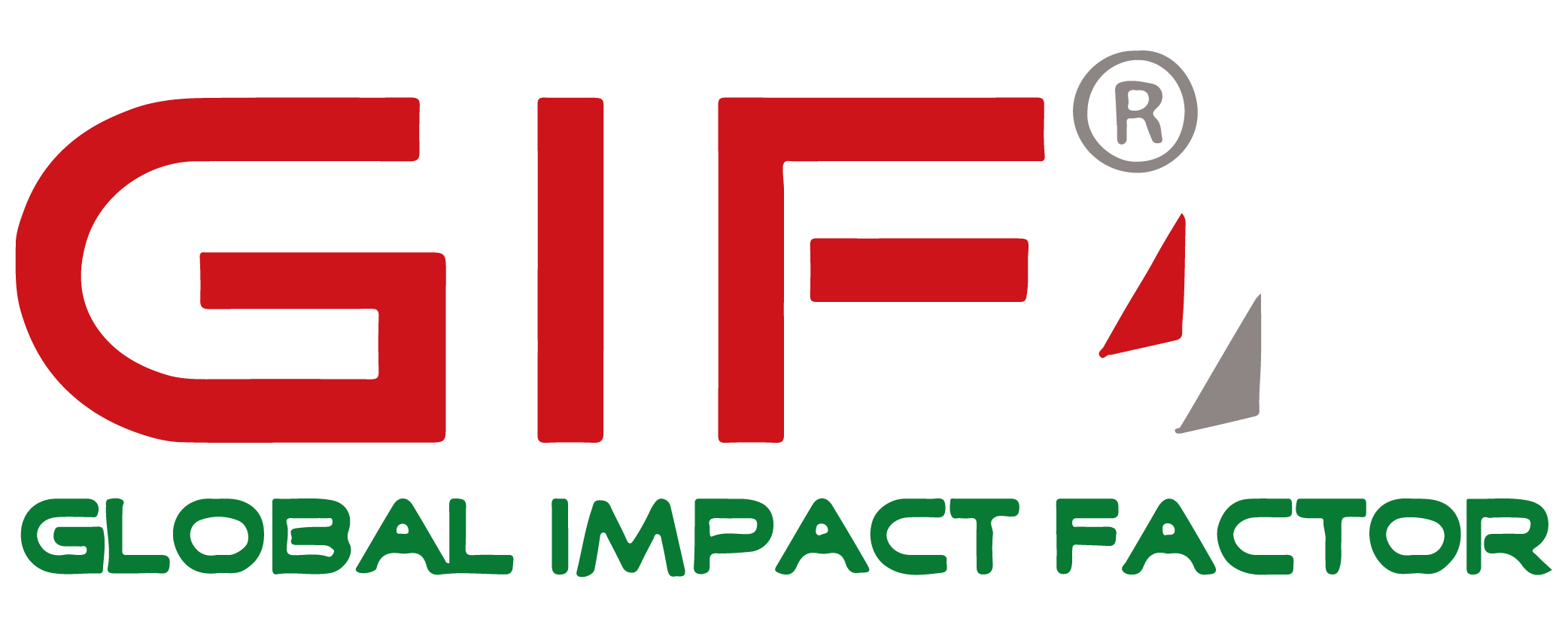Temalı Kafelerin Atmosferine Yönelik Tripadvisor Yorumlarının İncelenmesi (Examining Tripadvisor Comments Regarding the Atmosphere of Themed Cafes)
DOI:
https://doi.org/10.21325/jotags.2024.1528Keywords:
Themed cafe, Atmosphere dimensions, TripadvisorAbstract
The aim of this study is to identify the positive and negative comments on the atmospheric dimensions of cafes listed on Tripadvisor, as expressed by domestic and international consumers visiting themed cafes, and to provide recommendations to businesses based on these comments. This study is designed in a netnographic pattern, one of the qualitative research designs. It is significant for business owners who operate or intend to open themed cafes, as it highlights the critical points to consider regarding atmospheric dimensions. The sample of the study consists of themed and concept cafes located in Istanbul and Ankara that have reviews on Tripadvisor. Within the scope of the research, 1,080 reviews made on Tripadvisor for 14 themed cafes operating with themes such as TV shows and films, literature, nostalgia, and nature in Istanbul and Ankara were analyzed. The analyzed reviews were examined using percentage, frequency, and Chi-Square analysis methods. The content of the reviews was matched with atmospheric dimensions based on the keywords used. The study revealed that the atmospheric dimensions directly influenced the ratings given by consumers to cafes. It was observed that the ambiance dimension received the most positive feedback from consumers. Negative comments on themed cafes highlighted issues such as noise, cleanliness and hygiene, location, and menu design, suggesting improvements in these atmospheric dimensions.
References
Akkaya, Ö. (2021). Pazarlamanın Nitel Çağı Araştırma Desenleri, Kuramlar ve Uygulamalar. Netnografik Araştırma. İstanbul: Çizgi Kitabevi Yayınları.
Alan, A. K., Kabadayı, E. T. & Çavdar, N. (2017). Which physical environment dimensions really affect people in restaurants?. Social & Behavioural Sciences, 77-88.
Anaam, F. (2023). Effect of Ambience in the Restaurant Industry (Published Ph. D. thesis). Saudi Arabia: Effat University,
Ariffin, H. F., Bibon, M. F. & Abdullah, R. P. S. R. (2012). Restaurant’s atmospheric elements: What the customer wants. Procedia-Social and Behavioral Sciences, 38, 380-387.
Arslan, J. (2019). Markaların Mekânlaşması: Apple Markası Üzerinden Bir Değerlendirme. (Yayınlanmış Yüksek Lisans Tezi). İstanbul: Marmara Üniversitesi, Güzel Sanatlar Enstitüsü.
Ayazlar, R. A. & Gün, G. (2018). Yiyecek deneyiminin müşteri memnuniyeti ve davranışsal niyetine etkisi, KSBD, 10(10), 377-397.
Ayazlar, R., A. & Gün, G. (2017). Restorandaki fiziksel çevre unsurlarının algılanması, Journal of Tourism and Gastronomy, 5(2), 138-150.
Baş, M. (2018). Algılanan Otel İmajının Davranışsal Niyetler Üzerine Etkisi: Marmaris’teki 5 Yıldızlı Otellerde Bir Araştırma. (Yayınlanmış Yüksek Lisans Tezi). Muğla: Muğla Sıtkı Koçman Üniversitesi, Sosyal Bilimler Enstitüsü.
Beardsworth, A. & Bryman, A. (1999). Late modernity and the dynamics of quasification, Sociological Review, 47(2), 228-257.
Bengül, S. S. & Güven, Ö. Z. (2018). Yiyecek içecek işletmelerinde fiziksel ortam kalitesi, yiyecek kalitesi ve servis kalitesinin algılanan değer, müşteri memnuniyeti ve müşteri bağlılığı üzerindeki etkisi, Balıkesir Üniversitesi Sosyal Bilimler Enstitüsü Dergisi, 22(42), 375-405.
Bilgin, Y. (2017). Restoran işletmelerinde hizmet kalitesi, müşteri memnuniyeti ve müşteri sadakatinin ağızdan ağıza pazarlamaya etkisi, Journal of Business Research, 9(4), 33-62.
Bitner, M. (1992). Servicescapes: The impact of physical surroundings on customers and employees, Journal of Marketing, 56(2), 57-71.
Cankül, D., Cankül, I. & Iltaş, T. (2022). Gastronomi ve sanat ilişkisi, Turizmde Araştırma Temaları, 122-127.
Cetin, G., & Walls, A. (2015). Understanding the customer experiences from the perspective of guests and hotel managers: Empirical findings from luxury hotels in Istanbul, Turkey. Journal of Hospitality Marketing & Management, 1-47.
Çapaş, M. & Yılmaz, M. (2022). Tabak renginin besin algısı üzerine etkisi. Journal of Tourism and Gastronomy Studies, 10(4), 3699-3712.
Çetin, A. (2019). Restoran atmosferi algısının sosyal medya paylaşımlarına etkisi: Bir temalı restoran örneği, Manas Sosyal Araştırmalar Dergisi, 8(1), 639-653.
Çetintürk, N. (2014). Mağaza Atmosferi. İstanbul Açık ve Uzaktan Eğitim Fakültesi.
Erdil, T. S. ve Uzun, Y. (2010). Marka Olmak, İstanbul: Beta Yayıncılık.
Eren R. & Çelik M. (2017). Çevrimiçi gastronomi imajı: Türkiye restoranlarının Tripadvisor yorumlarının içerik analizi, Turizm Akademik Dergisi, 4(2), 121-138.
Gençtürk, B. (2020). Deneyimsel Pazarlama ve Algılanan Hizmet Kalitesinin Marka Sadakatine Etkisi: Kahve Mağazaları Örneği. (Yayınlanmış Yüksek Lisans Tezi). Aydın: Aydın Adnan Menderes Üniversitesi, Sosyal Bilimler Enstitüsü.
Gürcü, E. & Demirkol, Ş. (2023). Türkiye’deki uçak temalı restoranlara yönelik e-şikâyetlerin değerlendirilmesi, Journal of Tourismand Gastronomy Studies, 11(1), 347-371.
Hassan, I. & Iqbal, J. (2016). Employing sensory marketing as a promotional advantage for creating brand differentiation and brand loyalty. Pakistan Journal of Commerce and Social Sciences, 10(3), 725-734.
Heung, V. C. S. & Gu, T. (2012). Influence of restaurant atmospherics on patron satisfaction and behavioral intentions, International Journal of Hospitality Management, 1167–1177.
Heung, V. C. S. (2002). American theme restaurants: A study of consumer’s perceptions of the important attributes in restaurant selection. Asia Pacific Journal of Tourism Research, 7(1), 19-28.
Holder, M. & Berndt, A. (2011). The Effect of changes in servicescape and service quality perceptions in a maternity unit, International Journal of Health Care Quality Assurance, 24(5), 389-405.
Hsu, H. L., Lee, S. H. & Li, Y. H. (2009). A cognitive analysis of customer preferences regarding themed restaurants in Taiwan, Journal of Global Business Management, 5(1).
İbiş, S. (2021). İstanbul’daki asırlık restoranlar ve bu restoranlara yönelik çevrimiçi yorumların incelenmesi, Yönetim, Ekonomi ve Pazarlama Araştırmaları Dergisi, 5(2), 127-139.
Kano, N., Seraku, N., Takahashi, F. & Tsuji, S. (1984). Attractive quality and must -be quality hinshitsu, The Journal of the Japanese Society for Quality Control, 39-48.
Karaca, K., Ç. & Köroğlu, Ö. (2018). Restoran atmosferinin tekrar ziyaret niyetine etkisi: Akış deneyiminin aracılık rolü, Avrasya Uluslararası Araştırmalar, 6(15), 776-797.
Kayalı, S. (2021). Mekan Sosyolojisi Bağlamında Kitap Kafelerin İnsan Ve Mekan Etkileşimi Açısından İncelenmesi: Ankara Örneği. (Yayınlanmış Yüksek Lisans Tezi). İstanbul: Marmara Üniversitesi, Sosyal Bilimler Enstitüsü.
Keskin, E., Solunoğlu, A. & Aktaş, F. (2020). Yiyecek içecek işletmelerinde memnuniyetin tekrar ziyaret niyeti üzerindeki etkisinde atmosfer ve sadakatin aracı ve düzenleyici rolü; Kapadokya örneği, Journal of Tourism and Gastronomy Studies, 8 (2), 1222-1246.
Kılıç, İ. & Pelit, E. (2004). Yerli turistlerin memnuniyet düzeyleri üzerine bir araştırma, Anatolia: Turizm Araştırmaları Dergisi, 15(2), 113-124.
Kılınç, O. & Çavuş, Ş. (2010). Yiyecek- İçecek Sektörüne Genel Bakış. M. Sarıışık, Ş. Çavuş ve K. Karamustafa (Ed.) Profesyonel Restoran Yönetimi: İlkeler, Uygulamalar ve Örnek Olaylar (s. 1-18). Ankara: Detay Yayıncılık.
Kim, G. W. & Moon, J. Y. (2009). Customers‟ cognitive, emotional, and actionable response to the servicescape: A test of the moderating effect of the restaurant type, International Journal of Hospitality Management, 28, 144-156.
Kotler, P. (1973). Atmospherics as a marketing tool, Journal of Retailing, 49(4), 48–64.
Kumaş, G. & Bilgili, B. (2023). Turizm işletmelerinin hizmet kalitesi algısında temizlik ve hijyenin öneminin irdelenmesi üzerine bir araştırma, Gastroia: Journal of Gastronomy and Travel Research, 7(3), 533-557.
Lin, Y. I. (2004). Evaluating a servicescape: The effect of cognition and emotion, International Journal of Hospitality Management, 23,163–178.
Nawawi, W., N., W., Kamarudin, W., N., B., W., Ghani, A., M. & Adnan, A., N. (2018). Theme restaurant: Influence of atmospheric factors towards the customers’ revisit intention, 6th AicQoL2018 Perhentian Island, 3(7), 35-41.
Özer, Ç., Akbulut, M. B. & Çevik, A. (2015). Temalı restoranlar, uluslararası örnekler ve Türkiye’de uygulanabilirliği, Avrasya Turizm Kongresi, 28-30.
Perçin, Ş. N. & Yiğit, S. (2020). Tripadvisor'da yer alan yiyecek ve içecek işletmeleri hakkındaki e-şikayetlerin değerlendirilmesi: Kapadokya bölgesi örneği, Journal of Tourism and Gastronomy Studies, 8(4), 2985-3001.
Polat, M. (2022). Restoran atmosferinin memnuniyet ve tekrar ziyaret niyeti üzerindeki etkisi, Journal of Tourismand Gastronomy Studies, 10(4), 2881-2900.
Ponnam, A. & Balaji, M. S. (2014). Matching visitation-motives and restaurant attributes in casual dining restaurants. International Journal of Hospitality Management, 37, 47–57.
Puspita, O. D. (2015). Physical evidence of small theme restaurant in Indonesia: A case study of ramen house, Procedia-Social and Behavioral Sciences, 169, 289-295.
Ryu, K. & Han, H. (2011). New or repeat customers: How does physical environment influence their restaurant experience?, International Journal of Hospitality Management, 30(3), 599-611.
Ryu, K. & Jang, S. (2007). The effect of environmental perceptions on behavioral intentions through emotions: The case of upscale restaurants, Journal of Hospitality & Tourism Research, 31(1), 56-72.
Ryu, K. & Jang, S. S. (2008). DINESCAPE: A scale for customers’ perception of dining environments. Journal of Food Service Business Research, 11(1), 2-22.
Şenel, P. & Yılmaz, H. (2020). Et restoranlarının iç mekân atmosferi: Temel ilkeler. Journal of Gastronomy, Hospitality and Travel, 4(2), 551-568.
Şeyhanlıoğlu, H. Ö., Hazarhun, E., Arıca, R. & Durdu, K. M. (2023). Yiyecek-içecek işletmelerine yönelik trıpadvısor’da yer alan paylaşımların incelenmesi: Batman örneği, Süleyman Demirel Üniversitesi Vizyoner Dergisi, 14(39), 877-898.
Temeloğlu, E., Taşpınar, O. & Soylu, Y. (2017). Yiyecek ve içecek işletmelerinde atmosfer, tüketim duyguları, müşteri menuniyeti ve yeniden satın alma davranışı arasındaki ilişkinin incelenmesi, Journal of Tourism and Gastronomy Studies, 5(2), 253-264.
Uçuk, C., Kahraman, A. G. & Özdemir, S. S. (2022). Tabak Prezantasyonunun kötü görünümlü yiyeceklerin kabulüne etkisi: Şırdan örneği. Journal of Tourism and Gastronomy Studies, 10(1), 171-192.
Uşaklı, A. (2016). Turistik Tüketici Deneyimi: Beş Yıldızlı Resort Otellerde Bir Uygulama. (Yayınlanmış Doktora Tezi). Ankara: Gazi Üniversitesi, Eğitim Bilimleri Enstitüsü.
Ünal, D., Akkuş, G. & Akkuş, Ç. (2014). Yiyecek içecek işletmelerinde atmosfer, duygu, memnuniyet ve davranışsal sadakat ilişkisi, Gazi Üniversitesi Turizm Fakültesi Dergisi, 1, 23-49.
Ünlü, H., Kıvanç, M. İ. & Apak, Ö. C. (2022). Yiyecek içecek işletmelerinde müşterilerin temizlik algısı: Bayburt ili örneği, Safran Kültür ve Turizm Araştırmaları Dergisi, 5(3): 402-417.
Weıss R. & Feınstein, A. H. (2004). CustomerSatisfaction of Theme Restaurant Attributes and Their Influence on Return Intent, Journal of Foodservice Business Reserach, 7(1), 23-41.
Wood, N. T. & Munoz, C. L. (2007). No rules, just right or is it? The role of themed restaurants as cultural ambassadors, Tourism and Hospitality Research, 7, 242-255.
Yıldırım, A., Şimşek, H. (2021). Sosyal Bilimlerde Nitel Araştırma Yöntemleri (12.Baskı). Ankara: Seçkin Yayıncılık.
YÖK (2024). Yüksek Öğretim Kurulu. Erişim: 24. 12. 2024, https://www.yok.gov.tr/universiteler/universitelerimiz
Downloads
Published
How to Cite
Issue
Section
License
Copyright (c) 2024 Journal of Tourism & Gastronomy Studies

This work is licensed under a Creative Commons Attribution-NonCommercial 4.0 International License.








